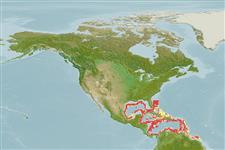Élasmobranches (requins et raies) (sharks and rays) >
Carcharhiniformes (Ground sharks) >
Pentanchidae (Deepwater catsharks)
Etymology: Apristurus: a-, Latin privative, i.e., without; pristis, from pristes (Gr.), sawyer (but here meaning saw); oura (Gr.), tail, referring to absence of saw-toothed crest of enlarged dermal denticles along upper edge of caudal fin as found in the closely related Pristiurus (=Galeus) (See ETYFish); parvipinnis: parvus (L.), small; pinnis (L.), fin, referring to first dorsal fin 2-4 times smaller than second dorsal fin (See ETYFish).
Environment: milieu / climate zone / profondeur / distribution range
Écologie
marin bathydémersal; profondeur 600 - 1380 m (Ref. 44037). Deep-water; 30°N - 6°N
Western Atlantic: northeastern Gulf of Mexico off Florida, Gulf of Campeche, Panama, Colombia, and off French Guiana. Had been originally termed Apristurus indicus by Springer (1966) but apparently not conspecific with the Indian Ocean species.
Taille / Poids / Âge
Maturité: Lm ? range ? - ? cm
Max length : 48.0 cm TL mâle / non sexé; (Ref. 244); 52.0 cm TL (female)
Second dorsal fin distinctly larger than the first (Ref. 13608).
Body shape (shape guide): elongated.
Found on the continental slope. Oviparous, apparently laying one egg per oviduct at a time. The most common Apristurus species in the Gulf of Mexico, along with A. laurussonii.
Life cycle and mating behavior
Maturité | Reproduction | Frai | Œufs | Fécondité | Larves
Oviparous, paired eggs are laid. Embryos feed solely on yolk (Ref. 50449).
Compagno, L.J.V., 1984. FAO Species Catalogue. Vol. 4. Sharks of the world. An annotated and illustrated catalogue of shark species known to date. Part 2 - Carcharhiniformes. FAO Fish. Synop. 125(4/2):251-655. Rome: FAO. (Ref. 244)
Statut dans la liste rouge de l'IUCN (Ref. 130435: Version 2025-1)
Menace pour l'homme
Harmless
Utilisations par l'homme
Pêcheries: pêcheries vivrières
Outils
Articles particuliers
Télécharger en XML
Sources Internet
Estimates based on models
Preferred temperature (Réf.
123201): 5.2 - 10.4, mean 6.4 °C (based on 83 cells).
Phylogenetic diversity index (Réf.
82804): PD
50 = 0.5000 [Uniqueness, from 0.5 = low to 2.0 = high].
Bayesian length-weight: a=0.00355 (0.00175 - 0.00721), b=3.08 (2.90 - 3.26), in cm total length, based on LWR estimates for this (Sub)family-body shape (Ref.
93245).
Niveau trophique (Réf.
69278): 3.9 ±0.6 se; based on size and trophs of closest relatives
Résilience (Réf.
120179): Très faible, temps minimum de doublement de population supérieur à 14 ans (Fec assumed to be <10).
Fishing Vulnerability (Ref.
59153): Moderate vulnerability (41 of 100).
🛈
